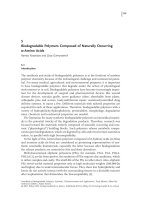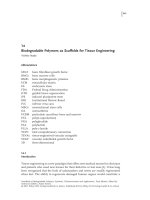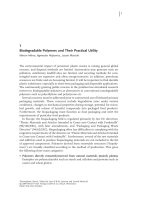Biodegradable polymers
Bạn đang xem bản rút gọn của tài liệu. Xem và tải ngay bản đầy đủ của tài liệu tại đây (294.12 KB, 13 trang )
Biodegradable Polymers
These are the polymers which gets decomposed by the process of
biodegradation.
Biodegradation is defined as a process carried out by biological
systems usually fungi or bacteria wherein a poly chain is cleaved via
enzymatic activity.
Degradation Mechanisms
Enzymatic degradation
Hydrolysis
(depend on main chain structure: anhydride > ester > carbonate)
Homogenous degradation
Heterogenous degradation
Requirement of biodegradation
Micro-organisms:
These micro-organisms must exist with the appropriate
biochemical machinery to synthesize enzymes specific for the target polymer
to initiate the depolymerization process.
Environment: Temperature, Pressure, Moisture, Oxygen, Type and
concentration of salts, Light etc.
Requirement of biodegradation
Substrate:
i) Suitable functional groups
ii ) Hydrophilicity
iii ) Low molecular weights
iv ) Less crystallinity
Types of biodegradable polymers
Natural biodegradable polymers
Natural
rubber, collagen, lignin, poly(gamma-glutamic acid), starch,
cellulose, gelatin, silk, wool etc.
Synthetic biodegradable polymers
Polyvinyl alcohol, polyanhydrides, PHBV or poly-(3-Hydroxybutyrate-CO-3Hydroxyvalerate), Polycaprolactum, Polylactic acid, Polyglycolide.
Synthetic or Natural Biodegradable Polymers?
Why We Prefer Synthetic Materials:
Tailor-able properties
Predictable lot-to-lot uniformity
Free from concerns of immunogenicity
Reliable source of raw materials
Polyesters
PCL (Poly caprolactone)
It is a thermoplastic biodegradable polyester synthesized by chemical
Conversion of crude oil, followed by ring opening polymerisation.
PCL has good water, oil, solvent and chlorine resistance. This polymer is often used as an additive for resins to improve their processing
characteristics and their end use properties (e.g., impact resistance). Being compatible with a range of other materials, PCL can be
mixed with starch to lower its cost and increase biodegradability or it can be added as a polymeric plasticizer to PVC.
Polycaprolactone is also used for splinting, modeling, and as a feedstock for prototyping systems such as a RepRap, where it is used
for Fused Filament Fabrication
PolyBIOPOL RESIN noates
O
HO
O
+
OH
HO
Microbially
Catalyzed
Depolymerization
Bacteria
Catalyzed
Polymerization
O
O
OH
O
n
O
m
Polyhydroxy buterate valerate (PHBV)
Need for biopolymers
Solid waste problems, particularly with regard to decreasing
availability of land fills
Litter problems
Entrapment or ingenious hazards to marine life.
Medical Applications of Biodegradable Polymers
Wound management
Sutures
Staples
Clips
Adhesives
Surgical meshes
Orthopedic devices
Pins
Rods
Screws
Tacks
Ligaments
Dental applications
Guided tissue regeneration Membrane
Void filler following tooth extraction
Cardiovascular applications
Stents
Intestinal applications
Anastomosis rings
Drug delivery system
Tissue engineering
Applications of biodegradable problems
The use of packaging materials produced from biopolymers (bio based polyesters) offers ecological
advantages over synthetic plastic packaging because they can be produced from renewable
PHB or poly(β-hydroxy butyrate) is used in the manufacture of shampoo bottles.
PLA or poly lactic acid: It breaks down in the environment back to lactic acid which can be metabolized
which has application in medical science such as sutures, drug delivery systems and wound clips. It has
also agricultural applications such as time release coatings for fertilizers and pesticides.
Limitations
Biodegradable polymers are very expensive.
They are not easily available.
In order to store potentially hazardous materials, landfills are built to be free of
moisture and air tight. These anaerobic conditions which serve to guard against
the release of hazardous chemicals from landfills also retard biodegradation.
Biodegradable
polymers are not suitable candidates in the recycling of
commingled plastics.









